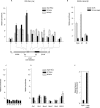Differential binding of replication proteins across the human c-myc replicator
- PMID: 16809765
- PMCID: PMC1592723
- DOI: 10.1128/MCB.02137-05
Differential binding of replication proteins across the human c-myc replicator
Abstract
The binding of the prereplication complex proteins Orc1, Orc2, Mcm3, Mcm7, and Cdc6 and the novel DNA unwinding element (DUE) binding protein DUE-B to the endogenous human c-myc replicator was studied by chromatin immunoprecipitation. In G(1)-arrested HeLa cells, Mcm3, Mcm7, and DUE-B were prominent near the DUE, while Orc1 and Orc2 were least abundant near the DUE and more abundant at flanking sites. Cdc6 binding mirrored that of Orc2 in G(1)-arrested cells but decreased in asynchronous or M-phase cells. Similarly, the signals from Orc1, Mcm3, and Mcm7 were at background levels in cells arrested in M phase, whereas Orc2 retained the distribution seen in G(1)-phase cells. Previously shown to cause histone hyperacetylation and delocalization of replication initiation, trichostatin A treatment of cells led to a parallel qualitative change in the distribution of Mcm3, but not Orc2, across the c-myc replicator. Orc2, Mcm3, and DUE-B were also bound at an ectopic c-myc replicator, where deletion of sequences essential for origin activity was associated with the loss of DUE-B binding or the alteration of chromatin structure and loss of Mcm3 binding. These results show that proteins implicated in replication initiation are selectively and differentially bound across the c-myc replicator, dependent on discrete structural elements in DNA or chromatin.
Figures








Similar articles
-
Activation of a human chromosomal replication origin by protein tethering.Nucleic Acids Res. 2013 Jul;41(13):6460-74. doi: 10.1093/nar/gkt368. Epub 2013 May 8. Nucleic Acids Res. 2013. PMID: 23658226 Free PMC article.
-
Site-specific loading of an MCM protein complex in a DNA replication initiation zone upstream of the c-MYC gene in the HeLa cell cycle.J Biol Chem. 2004 Aug 20;279(34):35879-89. doi: 10.1074/jbc.M401640200. Epub 2004 Jun 9. J Biol Chem. 2004. PMID: 15190069
-
Unique pattern of ORC2 and MCM7 localization during DNA replication licensing in the mouse zygote.Biol Reprod. 2012 Sep 13;87(3):62. doi: 10.1095/biolreprod.112.101774. Print 2012 Sep. Biol Reprod. 2012. PMID: 22674395 Free PMC article.
-
Interactions of MCP1 with components of the replication machinery in mammalian cells.Int J Biol Sci. 2011 Feb 17;7(2):193-208. doi: 10.7150/ijbs.7.193. Int J Biol Sci. 2011. PMID: 21383955 Free PMC article.
-
In search of the holy replicator.Nat Rev Mol Cell Biol. 2004 Oct;5(10):848-55. doi: 10.1038/nrm1495. Nat Rev Mol Cell Biol. 2004. PMID: 15459665 Free PMC article. Review.
Cited by
-
ATM deficiency augments constitutively nuclear cyclin D1-driven genomic instability and lymphomagenesis.Oncogene. 2014 Jan 2;33(1):129-33. doi: 10.1038/onc.2012.577. Epub 2013 Jan 14. Oncogene. 2014. PMID: 23318439 Free PMC article.
-
Regulation of the initiation step of DNA replication by cyclin-dependent kinases.Chromosoma. 2010 Dec;119(6):565-74. doi: 10.1007/s00412-010-0291-8. Epub 2010 Aug 5. Chromosoma. 2010. PMID: 20686781 Review.
-
Identification of new human origins of DNA replication by an origin-trapping assay.Mol Cell Biol. 2006 Oct;26(20):7731-46. doi: 10.1128/MCB.01392-06. Epub 2006 Sep 5. Mol Cell Biol. 2006. PMID: 16954389 Free PMC article.
-
Activation of a human chromosomal replication origin by protein tethering.Nucleic Acids Res. 2013 Jul;41(13):6460-74. doi: 10.1093/nar/gkt368. Epub 2013 May 8. Nucleic Acids Res. 2013. PMID: 23658226 Free PMC article.
-
Increased origin activity in transformed versus normal cells: identification of novel protein players involved in DNA replication and cellular transformation.Nucleic Acids Res. 2010 Apr;38(7):2314-31. doi: 10.1093/nar/gkp1192. Epub 2010 Jan 11. Nucleic Acids Res. 2010. PMID: 20064876 Free PMC article.
References
-
- Aggarwal, B. D., and B. R. Calvi. 2004. Chromatin regulates origin activity in Drosophila follicle cells. Nature 430:372-376. - PubMed
-
- Aladjem, M. I., L. W. Rodewald, J. L. Kolman, and G. M. Wahl. 1998. Genetic dissection of a mammalian replicator in the human beta-globin locus. Science 281:1005-1009. - PubMed
-
- Alexandrow, M. G., M. Ritzi, A. Pemov, and J. L. Hamlin. 2002. A potential role for mini-chromosome maintenance (MCM) proteins in initiation at the dihydrofolate reductase replication origin. J. Biol. Chem. 277:2702-2708. - PubMed
Publication types
MeSH terms
Substances
Grants and funding
LinkOut - more resources
Full Text Sources
